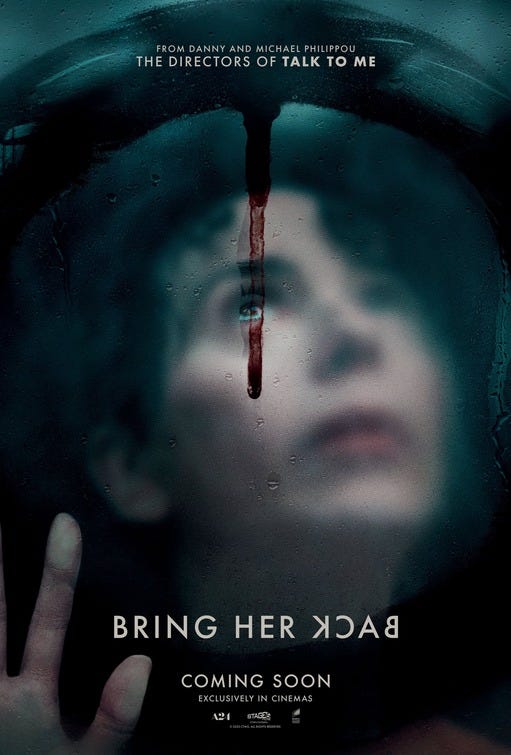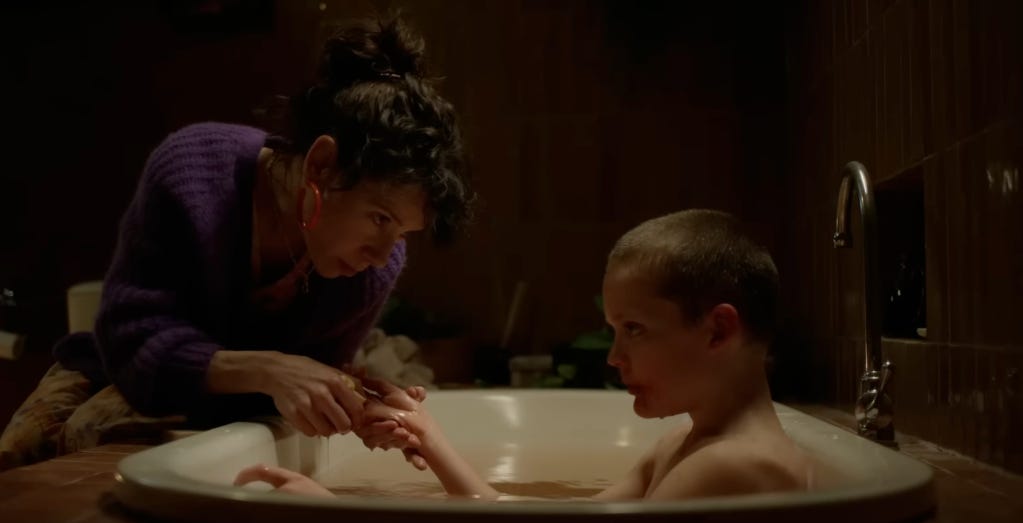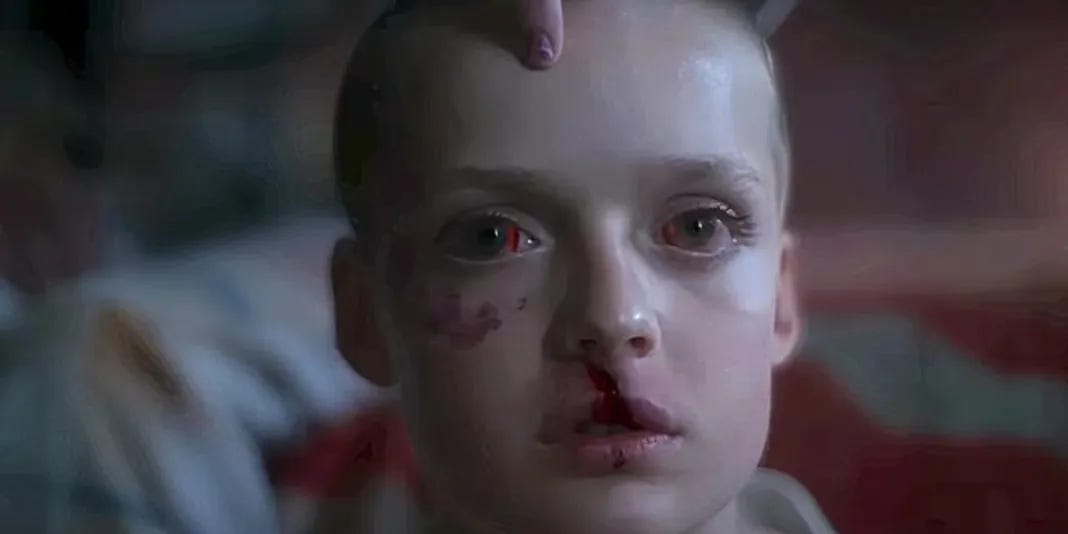Bring Her Back is a Harrowing and Unusually Sensitive Exploration of Grief and Mourning
It's Paddington's fish-fucking adopted mom like you've never seen her before!
I went into Bring Her Back blind. All I knew was that it was a follow-up to the acclaimed 2022 horror movie Talk to Her. I didn’t even know that it was Australian. The filmmakers could have tipped their hand with a poster featuring a kangaroo and a koala bear fighting or Paul Hogan’s winkingly caressing a large knife while giving Yahoo Serious a piggyback ride.
I don’t know if I would have chosen to see it if I’d known that it was about siblings coping with the traumatic aftermath of their father’s unexpected early death.
My father is in hospice care now. It’s hard to concentrate on anything but my father. Paradoxically, the entertainment that I’ve gravitated towards tends to be ghoulish and death-haunted in nature.
Nothing makes you forget the inexorable horror of life and the icy inevitability of death like immersing yourself in fictional horror and death.
I continue to rapaciously consume old horror comic books and movies, both new and old. And of course, I continue to binge-listen to the true-crime podcasts that my 10-year-old refers to as “murder shows”, not inaccurately.
My wife, who knows that I am sensitive and in a particularly delicate place right now, asked me more than once if I was okay, and I replied that I was.
Bring Her Back stars newcomer Sora Wong as Piper, a sight-impaired girl who is cared for by her older stepbrother, Andy (Billy Barratt). Andy is more than just the unusually vulnerable Piper’s protector and father figure. Since she cannot see anything other than shapes and colors, he is her eyes as well.
Andy tries to shield Piper from the world’s unrelenting ugliness, in general, and their family’s brutality, in particular. Rather than tell Piper the cold, hard truth, he softens things. This is particularly true of his relationship with their father. Literally and metaphorically, Andy endures life’s harsh blows so that Piper can hold onto what little innocence she has left.
The step-siblings think that they’ve lucked out when they end up in the care of Laura, a former social worker lost in a fog of grief and depression following the drowning death of her similarly sight-impaired daughter, Cathy.
Sally Hawkins plays Cathy. Hawkins is best known for her performance in Mike Leigh’s Happy Go Lucky, her role as Paddington’s adopted human mother in the Paddington trilogy and The Shape of Water, the Academy Award winner where she fucks a fish.
I did not see the movie where Hawkins fucked a fish-man. So I know the actress primarily from her wholesome roles in family fare.
The new foster mother initially seems warm and welcoming, but it doesn't take long for cracks to develop in her façade of maternal compassion. She’s an oversharer and a uniquely irresponsible mother figure.
When Andy flippantly tells Laura that his idea of a good time involves getting wasted, she eagerly volunteers to join him in the over-consumption of alcohol. Even more disastrously, she invites Piper, a child with no business drinking anything, to get properly smashed with her new caretaker.
At the funeral of the siblings’ father, Laura tells a despondent and unwilling Andy that he should kiss his father in his casket. He’s understandably mortified by her request, particularly when she ups the ante and insists that custom calls for him to kiss his dead, abusive father on the lips.
Hawkins delivers a spellbinding and nuanced performance that should result in her third Academy Award nomination. She was previously nominated for Happy Go Lucky and the movie where she fucked a fish.
Though Bring Her Back goes to some very dark, perverse places, particularly in terms of Hawkins’ character, at no point does she fuck a fish. That might have been specific to The Shape of Water. For the sake of the talented actress’s career, I’m glad that she has not been typecast as a fish-fucker.
The funeral scene is particularly masterful. Laura is sly and nuanced in her villainy. She does not bully Andy into doing something he desperately does not want to do through volume and force. Instead, she uses guile and psychology to push him into smooching his abusive, dead dad.
Laura also utilizes psychology in other ways. She favors Piper because she reminds her of the daughter whose death has scarred her irrevocably. Laura has clearly not gone beyond the denial stage of grief.
Andy already feels like an outsider. Laura pushing him away to get closer to Piper only exacerbates that feeling.
Piper and Andy are not the only foster children in Laura’s home. She’s also the foster mother of Oliver (Jonah Wren Phillips), a seemingly mute child who is the film’s breakout character and pure nightmare fuel.
Early in the film, we see Oliver picking up a cat in a way that suggests he’s eager to kill, eat, or kill and then eat the cat. That is never a good sign. When someone in a film abuses an animal, humans are invariably next.
Oliver is unwell. He grows more monstrous and less human with each passing scene. Once upon a time, Laura used her intellect to help troubled children with their problems, but Oliver is so troubled and lost that he seems beyond help.
Laura’s campaign of subtle psychological terror grows progressively more intense as Oliver continues to deteriorate physically, emotionally, and psychologically.
Literally and figuratively, Piper is blind to her foster mother’s true self and real intentions. She’s so overjoyed to experience a real connection in the wake of her father’s death that she overlooks clear signs of malevolence.
Bring Her Back represents Wong’s debut. That helps explain why her performance feels so raw, honest, and authentic. She delivers a naturalistic turn devoid of the precociousness that often characterizes child actors. All of the performances are remarkable, but Hawkins, Barratt, Wong, and Phillips deserve special praise for a film rich in depth and characterization.
The deaths here mean more because the movie makes us care about the characters and their lonely predicament. It even finds empathy for Laura, who is a monster in so many ways, but also a product of grief and mourning.
Directors Danny Philippou and Michael Philippou, who honed their craft on YouTube before Talk to Her became A24’s top-grossing film, maintain a tricky tone of paranoia and dread.
They trust the audience’s intelligence and judgment enough to understand that what is darkly inferred is more resonant and terrifying than what is clumsily explained. They’ve created an unusually sophisticated and intelligent exploration of the dark places grief can take us, defined by atmosphere rather than cheap shocks.
According to Wikipedia, Bring Her Back, the brothers passed on an opportunity to direct a Street Fighter movie to work on Bring Her Back. I would love to see what an adaptation of an iconic video game from these brilliant weirdoes would look and feel like, but they made the right choice. Bring Her Back is an instant classic that gets under your skin and slithers its way into your psyche.
4.25 Stars out of 5














My brain just went to the concept of a "Sally Hawkins Dance" and just what that might involve. Probably making your date wear a bear costume, fuck a fish and kiss a corpse.
A brilliant movie, and a savvy review. I concur -- this was a real masterpiece.
Fyi, Sally Hawkins was not nominated for an Oscar for Happy Go Lucky (even though she should have been). She WAS nominated for Blue Jasmine, the Woody Allen film where she traded blows with a dominant Cate Blanchett. No other actress would have survived that matchup, but Hawkins went toe to toe despite a much less showy role.
Also, the brothers didn't make Talk To Her, they made Talk To ME. Good movie, but, y'know, just sayin'!
Fromtheyardtothearthouse.substack.com